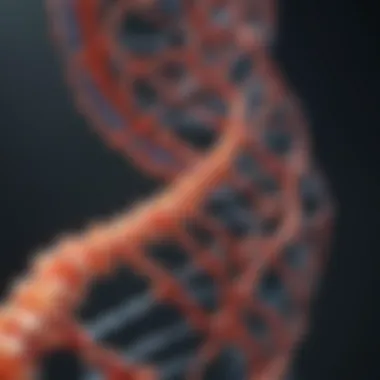Understanding SMA Carriers: A Comprehensive Overview


Intro
Spinal Muscular Atrophy (SMA) is a genetic disorder that affects motor neurons, leading to muscle weakness and atrophy. Understanding the concept of SMA carriers is vital to grasping the implications of this condition. Carriers of SMA have one copy of the mutated gene but typically show no symptoms. This article will provide an in-depth exploration of SMA carriers, their genetic makeup, implications for individuals and families, and management strategies related to this condition.
Background and Context
Overview of the Research Topic
SMA is caused by a mutation in the SMN1 gene, which is essential for the survival of motor neurons. Carriers of SMA possess one normal SMN1 gene and one mutated gene, putting them at risk for having children with the disorder. It is critical for families to understand their carrier status and the risks it presents.
Historical Significance
The significance of identifying SMA carriers has evolved over the years, particularly with advances in genetic testing. In the early days of SMA research, options for diagnosis and carrier status were limited. Recent developments in genetic testing have made it easier for individuals to uncover their genetic status. This shift has profound implications for reproductive decisions, family planning, and overall awareness of genetic disorders.
Key Findings and Discussion
Major Results of the Study
The understanding of SMA carriers has led to significant findings regarding the prevalence of the condition. Research indicates that approximately 1 in 40 to 1 in 60 individuals are carriers of the SMA gene mutation. Knowing this rate is crucial for families to consider testing options, especially when a family member is diagnosed with SMA.
Detailed Analysis of Findings
Carriers often do not experience symptoms; however, the risk of having children impacted by SMA heightens the importance of genetic counseling. Genetic testing is now widely available, allowing individuals to determine their carrier status and make informed decisions regarding family planning. Testing can include both carrier screening and the examination of family history. Research has also highlighted that direct-to-consumer genetic testing can play a role in carrier identification, but follow-up with a healthcare provider is recommended for accurate interpretation of results.
"Understand your genetic makeup to make informed decisions for your family."
In summary, the investigation of SMA carriers extends beyond simple genetic understanding. It encapsulates the broader implications for families navigating this genetic landscape. The knowledge gained through research fosters awareness and provides families the tools to make thoughtful choices regarding their health and future.
Epilogue
Understanding SMA carriers is not just about genetics; it touches on personal, familial, and social aspects of health. Conversations about SMA should include discussions about carrier status, genetic testing, and support systems available for families.
By deepening our comprehension of the nuances surrounding SMA carriers, we empower individuals and families to approach their genetic realities with clarity and confidence.
Defining SMA Carriers
Defining SMA carriers is paramount to appreciating the complexities of Spinal Muscular Atrophy (SMA). Understanding this topic sheds light on both the biological underpinnings and the societal implications of carrying the genetic mutations responsible for this disorder. Knowledge about SMA carriers allows individuals and families to make informed choices regarding reproductive options and medical interventions.
Understanding who qualifies as an SMA carrier relies fundamentally on genetics. Carriers of the condition often do not exhibit any symptoms but possess a mutation in the SMN1 gene. Their role is critical since they have the potential to pass this gene on to their offspring. Thus, this section serves to demystify the concept of carriers, presenting information that benefits those who may be affected or are considering starting a family.
Understanding Spinal Muscular Atrophy
Spinal Muscular Atrophy is a neurodegenerative disease primarily affecting motor neurons in the spinal cord. The condition leads to muscle wasting and weakness, progressively impacting essential motor functions like crawling, walking, and even breathing. SMA is classified into several subtypes, with Type 1 being the most severe form. The onset of symptoms can vary significantly, some appearing in infancy while others might not manifest until later in life. This variability underscores the importance of genetic understanding, affecting preventive strategies and family planning decisions.
The existence of multiple subtypes within SMA allows for different manifestations of the condition, which can vary in severity from mild to life-threatening. Educating those at risk of being carriers helps in understanding the implications of their genetic status.
Role of Genetic Carriers


Genetic carriers play an integral role in the transmission of SMA. Being a carrier does not equate to being affected by SMA, yet carriers have one normal copy and one mutated copy of the SMN1 gene. It is essential to note that this aspect could remain unknown for a considerable time, leading to unforeseen consequences during family planning. The key point to stress is that each child of two carrier parents has a 25% chance of being affected by SMA, a fact that can make carrier status particularly significant in reproductive discussions.
"Identification of SMA carriers is crucial for understanding and preventing the progression of Spinal Muscular Atrophy."
The benefits of recognizing one’s carrier status are numerous. It allows for informed family planning and the possibility of exploring options such as preimplantation genetic diagnosis during fertility treatments. In some cases, understanding carrier status can also facilitate timely interventions that may improve the quality of life for future generations. Thus, articulating the role of genetic carriers is essential in the context of managing SMA at both personal and broader public health levels.
Genetic Basis of SMA
Understanding the genetic basis of Spinal Muscular Atrophy (SMA) is essential in unraveling the complexities of this condition. It offers insight into how the disorder is inherited and how it can affect individuals. This exploration not only aids in identifying carriers but also informs treatment and management strategies. By grasping the genetic components involved, individuals and families can make more informed choices regarding their health and reproductive options.
The SMN1 and SMN2 Genes
The primary genes related to SMA are SMN1 and SMN2. The SMN1 gene is critical as it produces the Survival Motor Neuron (SMN) protein, vital for the health of motor neurons. A mutation or deletion in the SMN1 gene leads to reduced levels of this protein, causing the death of motor neurons and resulting in muscle weakness. In most cases of SMA, individuals lack at least one copy of the SMN1 gene.
On the other hand, SMN2 acts as a backup gene. However, its ability to compensate is limited. Although some SMN protein is produced by SMN2, much of it is incorrectly spliced, resulting in a lower functional protein level. The interaction between these two genes shapes the phenotype of SMA. For instance, the more copies of SMN2 present, the milder the SMA symptoms can be, suggesting a direct relationship between SMN2 copy number and disease severity.
This duality of the SMN genes highlights the importance of genetic testing in carrier screening and diagnosis. Identifying variants in these genes can be crucial for understanding the risk of having children with SMA.
Pathophysiology of SMA
The pathophysiology of SMA revolves around the degeneration of motor neurons in the spinal cord and brainstem. This degeneration leads to muscle atrophy because motor neurons are essential for muscle movement. When the SMN protein is deficient, vitamin transport mechanisms to motor neurons fail, which ultimately causes cell death.
SMA’s clinical manifestation varies widely, ranging from severe forms that lead to early death to milder cases where individuals may have near-normal lifespans. Understanding SMA's pathophysiology is key to developing therapies that target the underlying genetic causes. This insight has catalyzed advancements in treatment modalities, such as gene therapy, which aims to restore the function of SMN1 or enhance the production of SMN protein.
Understanding how SMA affects motor neurons is critical for advancing care strategies. The knowledge gained from studying the genetic basis and pathophysiology not only contributes to medical science but also empowers families and carriers to navigate their health journey with informed confidence.
"Comprehending the genetic underpinnings is paramount for proactive management of SMA"
This genetic knowledge provides a foundation for continued research and innovation in therapeutics, reflecting the evolving landscape of genetic disorders.
Carrier Frequency and Population Studies
Understanding carrier frequency and how it is studied in populations is essential for grasping the full impact of Spinal Muscular Atrophy (SMA). The concept of carrier frequency refers to the proportion of individuals in a population who carry a genetic mutation associated with a particular condition. For SMA, this knowledge can influence not just individual lives, but public health strategies and genetic counseling practices.
The importance of studying SMA carriers is multifaceted. First, it allows clinicians and researchers to estimate the likelihood of SMA occurring in future generations. By understanding how prevalent these genetic mutations are within specific communities, the risk for couples planning to have children can be assessed.
Furthermore, population studies can reveal variations in carrier frequency across different ethnic and geographical groups. These insights are critical for developing targeted screening programs and educational initiatives. They can help in designing public health interventions that aim to reduce the incidence of SMA, which can be particularly valuable in communities where the carrier rate is significantly higher.
Studies show that carrier frequencies for SMA can vary widely, highlighting the need for targeted awareness and education in at-risk populations.
Epidemiology of SMA Carriers
The epidemiology of SMA carriers provides a systematic approach to understanding the distribution and determinants of carrier status in populations. Research indicates that approximately 1 in 40 to 1 in 60 individuals in certain populations are carriers of the SMN1 gene mutation, which is primarily responsible for SMA.
This statistical awareness plays a key role in public health. By capturing data through epidemiological studies, health professionals can identify high-risk groups and encourage genetic testing for those who may be affected. Most importantly, such studies contribute to creating a more informed society, which can make educated decisions about family planning and health management.
Ethnic Variability in Carrier Status
Carrier status for SMA is not uniformly distributed across different ethnicities. Studies reveal that certain populations show higher frequencies of SMN1 gene mutations. For instance, among Ashkenazi Jewish individuals, the carrier frequency can be as high as 1 in 27. Other groups, such as individuals with Northern European ancestry, also demonstrate significant carrier rates.


This ethnic variability necessitates tailored approaches in genetic counseling and screening. Health care providers must consider these differences when discussing SMA risks with patients. Understanding the unique genetic landscape of specific communities can aid in formulating effective educational and preventative strategies.
In summary, the comprehensive understanding of SMA carrier frequency and its epidemiological implications is crucial for informed health choices and planning. It highlights the need for ongoing research and education in diverse communities to effectively address the challenges presented by SMA.
Testing for SMA Carrier Status
Testing for SMA carrier status plays a vital role in understanding Spinal Muscular Atrophy (SMA) and its implications for individuals and families. This testing enables better awareness of genetic risks associated with SMA. For couples planning a family or those having a family history of SMA, these tests are essential. Identifying carrier status allows informed reproductive decisions, leading to better management of any potential risks.
The process generally includes genetic counseling and the selection of appropriate tests. Discussing the outcomes with a healthcare professional helps individuals comprehend the meaning of their carrier status. This knowledge can profoundly impact family planning choices and psychosocial well-being.
In addition to reproductive implications, testing serves as a tool for awareness. Knowledge about carrying the SMA gene offers a chance to prepare for possible future challenges. Carrier testing raises awareness among family members, potentially leading them to consider their own carrier status.
"Understanding one's SMA carrier status can be pivotal for informed decision-making in family planning and genetics."
Types of Genetic Tests Available
There are several types of genetic tests available for SMA carrier status assessment. Some key tests include:
- SMN1 Deletion Test: This is the primary test used to identify deletions in the SMN1 gene, crucial for SMA development. A positive result indicates carrier status.
- SMN2 Copy Number Analysis: This test evaluates the number of SMN2 gene copies present since variations can influence disease severity.
- Targeted Mutation Analysis: This is often employed when a family member is known to have SMA. It screens for specific mutations related to SMA.
Each of these tests provides unique insights into carrier status and assists in genetic counseling. The choice of test may depend on family history or specific symptoms observed.
Counseling Before and After Testing
Genetic counseling is integral before and after testing for SMA carrier status. Before testing, counselors help individuals understand the types of tests available and the potential emotional and medical implications of the results. They provide a supportive environment for discussing concerns and motivations behind testing.
After testing, counseling continues as individuals and families interpret the results. Understanding a positive test can be overwhelming. Counselors guide families through the implications, including genetic risks to children, emotional challenges, and family dynamics. They also discuss options for family planning, such as pre-implantation genetic diagnosis (PGD) or sperm/egg donation.
Counseling addresses the psychosocial aspects of being a carrier. It includes strategies for support and coping mechanisms. This helps individuals to navigate their carrier status while emphasizing a balanced perspective about the future.
Implications of Being an SMA Carrier
The implications of being an SMA carrier are multifaceted, encompassing genetic, reproductive, and psychosocial dimensions. Understanding these aspects is crucial for individuals identified as carriers of the spinal muscular atrophy (SMA) gene mutation. Carriers often grapple with the potential impact of their genetic status on personal and familial decisions. This section will outline significant considerations that SMA carriers face and the various dimensions of life that their status can influence.
Reproductive Choices for Carriers
For SMA carriers, reproductive choices take on heightened significance. A carrier has a 25% chance of passing on the condition to their offspring if both parents are carriers. This reality necessitates thoughtful consideration about family planning. Many carriers might opt for genetic counseling to gain insights into their options. Here are key reproductive choices:
- Preimplantation Genetic Diagnosis (PGD): This technique allows for the selection of embryos without the SMA gene mutation during in vitro fertilization (IVF).
- Prenatal Testing: Carriers can pursue testing during pregnancy to determine if the baby has inherited the condition. This can include amniocentesis and chorionic villus sampling (CVS).
- Donation of Sperm or Eggs: If concerns about transmitting SMA are paramount, some may choose to use donor reproductive cells that do not carry the SMA mutations.
- Adoption: Some couples consider adoption as a way to build a family without the genetic risks associated with SMA.
Each option presents unique emotional and ethical challenges. Therefore, detailed discussions with healthcare professionals and thorough research can guide decision-making.
Psychosocial Effects of Carrier Status
The psychosocial effects of being an SMA carrier are considerable and can manifest in various ways. Carriers might experience anxiety or guilt related to their genetic status, particularly regarding the possibility of affecting their future children. Common psychosocial aspects include:
- Anxiety and Stress: Knowing one’s carrier status can create anxiety about health risks, not just for oneself but also for future generations.
- Identity and Stigma: Some carriers may struggle with their identity, fearing societal stigma, especially when others are unaware of the condition's implications.
- Support Systems: Developing a support network is often beneficial. Many find comfort in connecting with support groups, whether online or in person, sharing experiences with others in similar situations.
- Communication with Family: Discussing carrier status with family can be challenging yet necessary. Open conversations can foster understanding and support, reducing feelings of isolation.


"The experience of being a carrier of SMA can shape one’s journey in profound ways, influencing choices and relationships."
SMA Carrier Management Strategies
Understanding the management strategies available for SMA carriers is crucial for empowering individuals and families impacted by Spinal Muscular Atrophy. This approach not only provides essential information but also equips carriers with the necessary tools for effective navigation through the complexities of their genetic status. The right management strategies can improve quality of life and enhance decision-making regarding health, family planning, and emotional well-being.
Educational Resources for Carriers and Families
Access to educational resources is vital for SMA carriers and their families. These resources help in unpacking the scientific and social implications of being an SMA carrier. Various organizations and initiatives provide comprehensive information detailing the nature of SMA, the role carriers play in genetic transmission, and the latest research developments.
- Online platforms: Websites like Wikipedia and Britannica are significant starting points for understanding the basic genetics of SMA.
- Webinars and workshops: Many nonprofit organizations host educational webinars, offering insights from experts in the field. These sessions often address queries and concerns of carriers.
- Literature and pamphlets: Informative pamphlets provided by healthcare providers can serve as practical guides covering essential information on SMA and carrier implications.
Involving healthcare professionals in discussions about educational content can also help families make informed choices while feeling supported.
Support Groups and Networks
Support groups and networks serve as critical resources for SMA carriers, aiding in the development of community and shared experiences. These groups foster emotional support, advocacy, and education among members. Being part of such networks can significantly lessen feelings of isolation that may occur due to the carrier status.
- Local and online support groups: Many communities have organizations that offer in-person meetups. Additionally, online forums, such as those found on Reddit or specialty Facebook groups, provide a platform for sharing personal stories and disseminating information relevant to SMA carriers.
- Peer-to-peer connections: Establishing connections with other carriers can lead to friendships and support systems that empower individuals to discuss their challenges and successes openly.
- Advocacy networks: Organizations focused on advocating for SMA research and carrier awareness can keep families informed about advancements and policy changes.
"Being part of a community helps in understanding that you are not alone in this journey."
Through both educational resources and strong support networks, SMA carriers can face their challenges with greater knowledge and emotional backing. Together, these management strategies foster a sense of empowerment, ensuring that carriers and their families can approach life with confidence.
Research and Future Directions
Understanding the research landscape surrounding SMA carriers is pivotal for numerous reasons. As investigations explore the genetic, psychosocial, and medical implications of carrier status, fresh insights emerge that can directly impact treatments and the quality of life for affected individuals and their families. Research into SMA carries profound ethical implications too, influencing carrier testing practices and informing the choices made by prospective parents.
Ongoing Studies on SMA Carriers
Current studies on SMA carriers are crucial for identifying the penetrance and variable expressivity of the disease. Many researchers are focusing on understanding how the presence of the SMN1 gene deletion affects carriers. While carriers usually do not express severe symptoms of SMA, some show mild signs.
Recent studies have initiated a large-scale genomic analysis across diverse populations. The aim is to understand the carrier frequency better and identify potential modifiers of disease severity. Investigating these factors can guide genetic counseling practices. Also, studies are examining how environmental factors interact with genetic predispositions to influence carrier status.
In addition, collaborations among geneticists, neurologists, and ethicists are exploring the psychosocial aspects of being a carrier. These studies seek to evaluate the emotional impact of carrier status and how it affects family dynamics. Results from these studies are valuable for developing counseling interventions that can support carriers emotionally.
Advancements in Gene Therapy
The domain of gene therapy represents one of the most promising areas of research for SMA. A number of advanced therapeutic approaches are being developed to target the genetic root of the condition. Notably, therapies like Nusinersen (Spinraza) have already shown effectiveness in enhancing the lifespan and function of those affected by SMA.
Ongoing research is delving into innovative avenues such as CRISPR-Cas9 gene editing. This technology offers the potential to correct the fundamental genetic defects associated with SMA. While still largely experimental, initial results appear promising. Furthermore, researchers investigate small molecules and RNA modulation techniques to enhance SMN protein levels, which is critical for motor neuron health.
As the field progresses, it is crucial to consider the ethical and safety concerns surrounding gene therapies. Clinical trials must ensure rigorous follow-up on the long-term effects of these treatments on both carriers and affected individuals.
In summary, the research surrounding SMA carriers is a landscape of exploration and potential. With ongoing studies and advancements in therapeutic interventions, these efforts not only seek to enrich scientific understanding but also aim to improve the lives of those impacted by Spinal Muscular Atrophy.
Culmination
The conclusion of this article serves as a pivotal reflection on the significance of understanding SMA carriers and the multifaceted implications that accompany carrier status. Spinal Muscular Atrophy, as a genetic disorder, brings to light not only scientific and medical considerations but also profound personal and familial impacts. By synthesizing the information presented on the genetic basis, carrier frequency, and testing options, we aim to provide a holistic understanding that can guide individuals and families in making informed decisions.
One crucial element addressed is the role of genetic counseling. This should not be overlooked, as professional guidance can clarify uncertainties regarding carrier status, reproductive choices, and implications for family planning. Moreover, acknowledging the psychosocial effects that may accompany being a carrier is essential. The emotional toll on individuals as well as family dynamics can shape their experiences and decisions.
In addition, the ongoing research into SMA carriers and advancements in gene therapy are highlighted as reasons for optimism. Knowledge about genetic make-up continues to evolve, creating new opportunities for intervention and support. This presents carriers and their families not just with challenges but also with possibilities for managing the condition more effectively.
To summarize, understanding SMA carriers encompasses a broad scope of discussion, from genetics to psychological effects. Grasping these complexities allows for enhanced awareness, better communication, and proactive health management. As we advance in our understanding, we empower those affected by SMA, facilitating informed choices and group solidarity.







